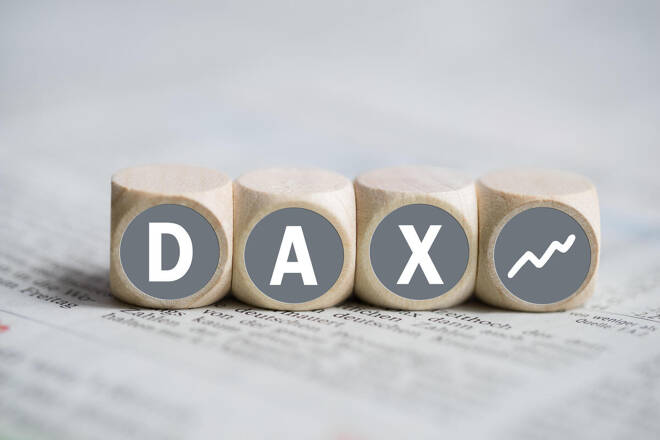Advertisement
Advertisement
DAX Set for a Bullish Open with German Trade in the Spotlight
By:
Highlights It was a bearish start to the third quarter for the DAX, falling 0.41% to end the day at 16,081. Disappointing manufacturing PMI numbers from
Highlights
- It was a bearish start to the third quarter for the DAX, falling 0.41% to end the day at 16,081.
- Disappointing manufacturing PMI numbers from Germany and the US weighed on investor sentiment.
- Later today, German trade data will draw interest, while there are no US economic indicators to consider on the Fourth of July holiday.
It was a bearish start to the third quarter for the DAX, which fell by 0.41%. Partially reversing a 1.26% gain from Friday, the DAX ended the day at 16,081. Despite the bearish session, the DAX avoided sub-16,000 for the first time since June 21.
Economic indicators from Germany, the euro area, and the US weighed on the DAX. However, disappointing manufacturing PMI numbers from China reignited bets of more stimulus from Beijing to limit the damage.
The Caixin Manufacturing PMI fell from 50.9 to 50.5 in June versus a forecasted 50.2. Weak global demand was a drag at the end of the second quarter.
Economic Indicators Weighed on Investor Sentiment
It was a busy start to the quarter on the European economic calendar. Manufacturing PMI numbers for Italy and Spain and finalized numbers for France, Germany, and the Eurozone were in focus.
Investors hoping for the Eurozone economy to show signs of life will need to wait some time considering the latest surveys and the ECB’s commitment to tackling inflation.
Italy’s manufacturing PMI fell from 45.9 to 43.8, with the German manufacturing PMI down from 43.2 to 40.6 (Prelim: 41.0). As a result, the Eurozone manufacturing PMI declined from 44.8 to 43.4 (Prelim: 43.6).
A deeper contraction across the manufacturing sector leaves the services sector to take the strain. However, service sector growth also slowed according to prelim numbers. Persistent inflationary pressures, higher interest rates, and economic uncertainty leave the euro area economy in a precarious state.
US manufacturing sector PMIs failed to change the mood. The preferred ISM Manufacturing PMI fell from 46.9 to 46.0 versus a forecasted 47.2. Notably, the ISM Manufacturing Prices Index fell from 44.2 to 41.8, with the Employment Index down from 51.4 to 48.1.
The Market Movers
It was a mixed Monday session for the auto sector. Continental AG and Porsche tumbled by 3.85% and 3.30. respectively, with BMW and Mercedes-Benz Group seeing losses of 0.28% and 0.07%, respectively. However, Volkswagen bucked the trend, rising by 0.68%.
It was a bullish session for the banks. Commerzbank and Deutsche Bank saw gains of 0.64% and 1.16%, respectively.
Continental and Porsche were among the worst performers, with Siemens AG and Siemens Healthineers also at the bottom of the table. While the manufacturing PMIs were a drag, AstraZeneca news weighed on the healthcare sector.
The Day Ahead for the DAX
It is a relatively quiet day ahead on the European economic calendar. However, German trade data will draw interest early in the European session.
After disappointing manufacturing PMIs from Monday, a marked narrowing in the German trade surplus would test buyer appetite. Economists forecast Germany’s trade surplus to widen from €18.4 billion to €19.1 billion in May.
Investors should also consider central bank chatter. However, no ECB Executive Board Members are on the calendar to speak today, leaving commentary with the media to influence.
Later in the day, there are no US economic indicators to draw interest, with the US markets closed for the Fourth of July holiday.
DAX Technical Indicators
Looking at the EMAs and the 4-hourly chart, the EMAs sent bullish signals. The DAX sat above the 50-day EMA (16,023). The 50-day EMA pulled away from the 200-day EMA, sending bullish signals.
A hold above the 50-day EMA would support a return to 16,200 and give the bulls a run at the lower level of the 16,330 – 16,380 resistance range. However, a fall through the 50-day EMA (16,023) would bring the 200-day EMA (15,836) and the upper level of the 15,820 – 15,780 support range into view.
The 14-4H RSI sits at 55.37, sending moderately bullish signals and supporting a return to 16,200 to target the 16,330 – 16,380 resistance range.
For a look at the economic events, check out our economic calendar.
About the Author
Bob Masonauthor
With over 28 years of experience in the financial industry, Bob has worked with various global rating agencies and multinational banks. Currently he is covering currencies, commodities, alternative asset classes and global equities, focusing mostly on European and Asian markets.
Did you find this article useful?
Latest news and analysis
Advertisement
